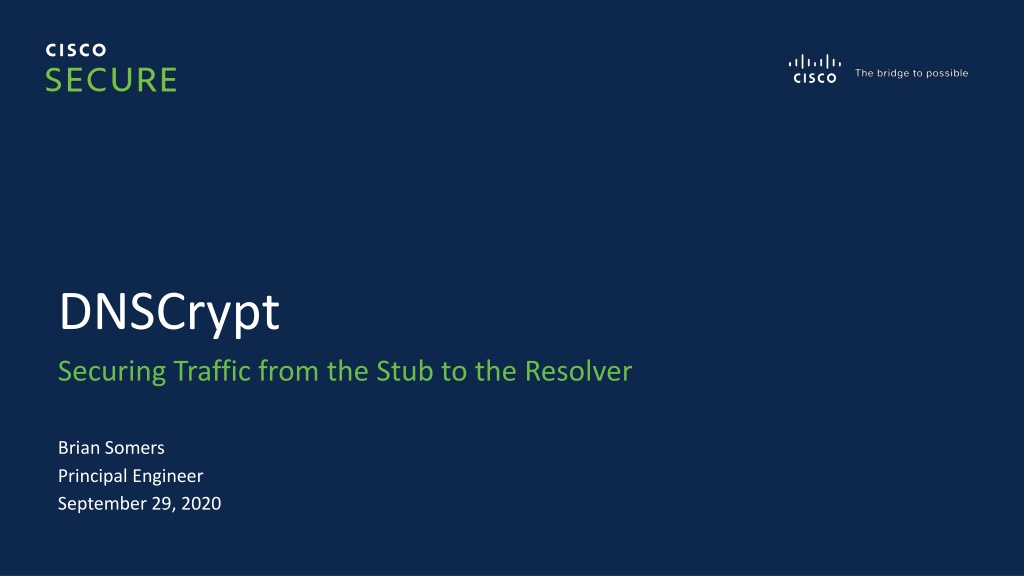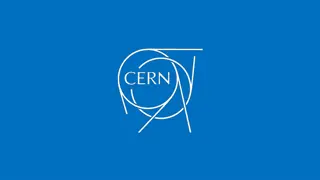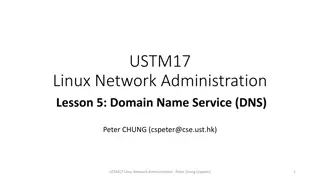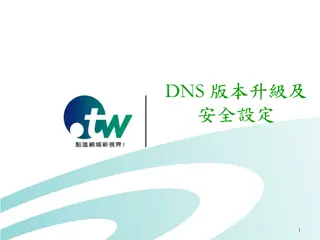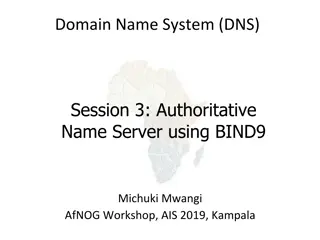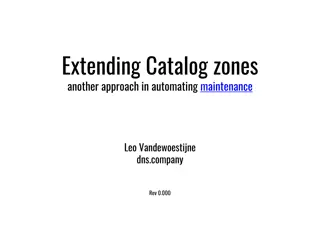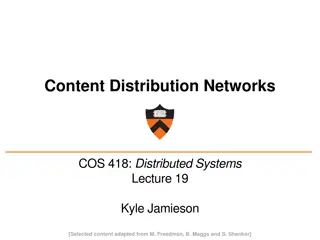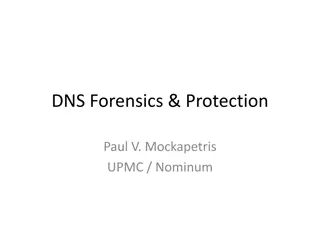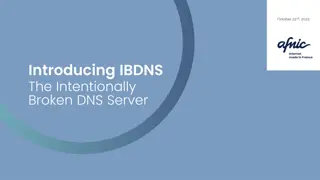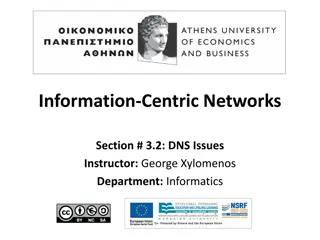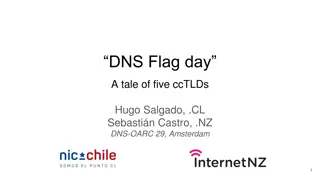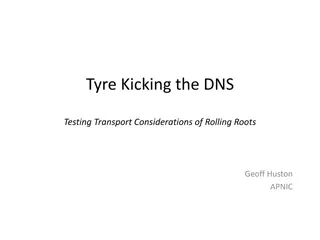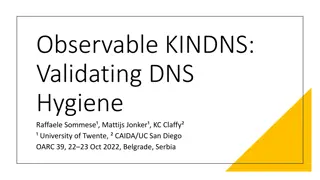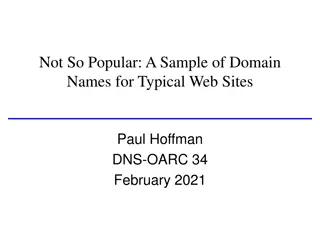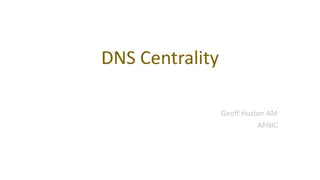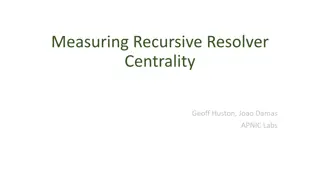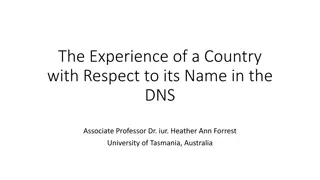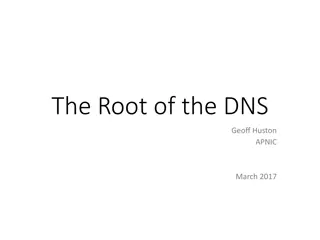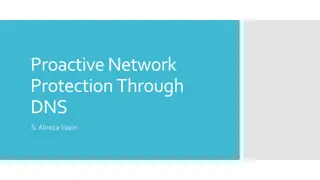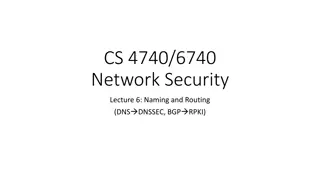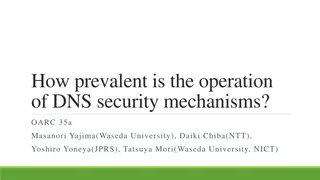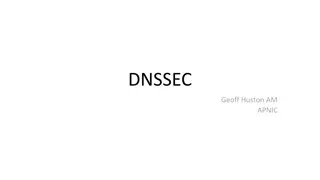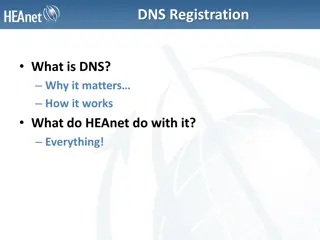Understanding DNSCrypt: Securing Data Traffic from Stub to Resolver
DNSCrypt is a valuable tool that enhances security and privacy by encrypting traffic between the DNS stub and resolver. It ensures data integrity, privacy, and protection against potential threats like DDoS attacks and malware. By implementing DNSCrypt, users can trust the authenticity and confidentiality of their DNS queries and responses.
Download Presentation

Please find below an Image/Link to download the presentation.
The content on the website is provided AS IS for your information and personal use only. It may not be sold, licensed, or shared on other websites without obtaining consent from the author. Download presentation by click this link. If you encounter any issues during the download, it is possible that the publisher has removed the file from their server.
E N D
Presentation Transcript
DNSCrypt Securing Traffic from the Stub to the Resolver Brian Somers Principal Engineer September 29, 2020
The Landscape Agenda The Missing Piece How DNSCrypt Works DNSCrypt in the Wild TL;dr
The Landscape Nameservers Office / Home / ISP DNSSEC Resolver Original Modern Nameservers DNSSEC Resolver 3
Qualities of the remote resolver Good caching High demand data will likely be cached. The cache is populated by huge numbers of diverse clients. Low latency Enterprise resolvers running on anycast addresses. High availability Massive redundancy. Capable of mitigating DDoS attacks. Privacy Authorities learn very little about delegated lookups. Queries are not usually attributed to a specific client. Improved with qname minimization. Security enhancements DNSSEC validation will ensure data integrity. Immediate handling of malware, phishing and inappropriate content. 4
The missing piece Security from the stub to the resolver Without securing this data, all bets are off. No authentication The stub can t trust the AD bit. In fact, the stub can t trust the data! No privacy Everything is in plain sight. ISP eyes often mean government eyes. 5
DNSCrypt to the rescue Lives locally - Local network service - Local process - Built into the stub library Supports UDP and TCP 4k UDP bufsize is ok Uses Ec25519 [relatively] fast - CPU cost is ~2.5 times No known vulnerabilities (since 2008) 6
DNSCrypt pieces Offline Resolver Client Resolver private key Provider Provider public key DNSCrypt cert Provider private key Resolver public key Client keypair Signed using provider private key 7
DNSCrypt movements - provider Infrequent (not repeated for many many years) Provider creates keypair, hides the private key. DNSCrypt client software is configured with the public key. Occasionally (one or more times per year) Provider generates a new resolver keypair. Provider installs the resolver private key on the resolver. Provider creates a DNSCrypt certificate. - Embeds the resolver public key - Signs using the provider private key - Publishes as a DNS TXT RR 8
DNSCrypt movements client/resolver Every hour Client refreshes the DNSCrypt certificate TXT RR in its cache. Client validates the DNSCrypt certificate using the provider public key. Client chooses its favourite key. For each query Client encrypts using the resolver public key from the DNSCrypt certificate. Client embeds its public key in the query. Resolver decrypts the query using the resolver private key. Resolver encrypts the response using the client public key. Client decrypts the response using the client private key. Periodically (per session or per query) Client generates a client keypair. https://dnscrypt.info/protocol 9
DNSCrypt in the wild jigsaw-transparent-21.png 1 week Client (light blue), DNSCrypt (dark blue), Authoritative (yellow) 10
DNSCrypt TL;dr Privacy Captured traffic cannot be interpreted. Authentication The AD bit can be trusted. Administrative sanity No increased packet counts (although packets are larger). Traffic patterns are the same. Traffic is identifiable (queries and responses have magic). 11
Many implementations https://dnscrypt.info/implementations Some support DNSCrypt, DoH and DoT comparisons are easy. Many services https://dnscrypt.info/public-servers Next steps Frequently Asked Questions https://dnscrypt.info/faq A DNSCrypt RFC Doesn t yet exist It s probably well overdue! 12
